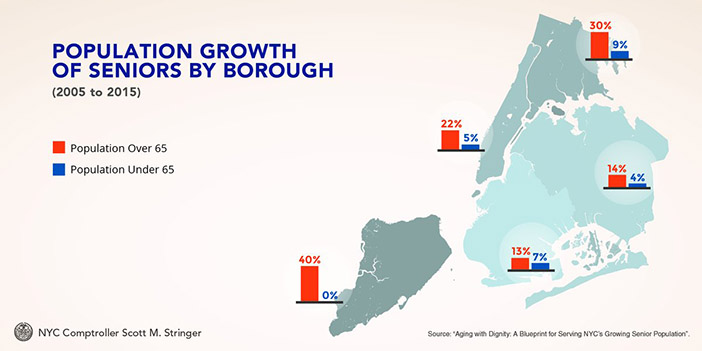Courtesy of the City Comptroller’s Office
By Forum Staff
City Comptroller Scott Stringer recently unveiled a new report that highlighted current challenges and the need for additional support for NYC’s senior population now and in the future.
In announcing the findings of the analysis – “Aging with Dignity: A Blueprint for Serving NYC’s Growing Senior Population” – Stringer called on the City to launch an agency-by-agency, neighborhood-by-neighborhood approach to serving its seniors.
“We need to act today – not tomorrow. Seniors are the anchors of our communities, and we must ensure they have the support they deserve. We need to have an all-hands-on-deck approach, from every City agency, because this is too important. As we face significant demographic changes, we need to reimagine how we support our current and future seniors,” Stringer said. “We hope these specific ideas and this blueprint will jumpstart a long-term conversation in the city – and help develop a long-term strategy – about how to deliver for New Yorkers for decades to come. Our approach should help more New Yorkers stay in their homes and age in place – it’s cheaper, it’s smarter, it allows New Yorkers to remain involved in their communities. Most importantly, it’s the right thing to do, and now is the time to act.”
According to the analysis, the growing population of New Yorkers aged 65 and older faces challenges with affordability, transportation, housing, and other obstacles. While calling for the City to perform long-term, comprehensive planning, Stringer’s blueprint lays out specific proposals that he said will be necessary to better serve seniors, including:
Creating Housing Options
Freezing rents by automatically enrolling New Yorkers in the Senior Citizens Rent Increase Exemption: Additional senior renters can more easily remain in their apartments if they are automatically enrolled in the Senior Citizens Rent Increase Exemption program, which freezes their rent. This change would add an estimated 26,000 seniors to the program.
Mitigating affordability challenges by expanding tax credits through the Senior Citizens Homeowners’ Exemption: To support seniors who own their homes, the City should expand eligibility for the Senior Citizens Homeowners’ Exemption to cover those with incomes up to $50,000. That would make approximately 29,000 more homeowners eligible for the program and mitigate affordability challenges.
Transforming age-friendly home improvements: The City should establish a program that helps seniors make their homes age-friendly through enhanced requirements on landlords, or new tax credits for homeowners, that finance modifications like widened doors, grab bars in bathrooms, and no-slip surfaces, as other cities already have.
Developing
More Liveable Communities
Creating tailored, neighborhood action plans by expanding the Age-Friendly Neighborhoods program: In 2010, the City launched the “Age-Friendly Neighborhoods” program, which created neighborhood action plans for over a dozen neighborhoods to better support seniors. To plan for the long-term, that program should be expanded significantly so communities can pinpoint their needs in a local way.
Eliminating senior center deserts by strengthening investments: Senior centers are not consistently located in places with a large number of seniors, which may be preventing seniors in certain neighborhoods from benefitting from services. Currently, certain neighborhoods –like borough communities Bayside, Queens Village, Cambria Heights; Bensonhurst in Brooklyn; and Tottenville, Staten Island – with large numbers of seniors have relatively few options, Stringer said. Studies show that seniors who do not utilize senior centers cite inconvenient locations as one of the top five reasons they do not attend. Additional funding and modernization of our senior centers is necessary to not only eliminate senior center deserts, but also to prepare for an aging population.
Significantly increasing the number of bus shelters and benches and bolstering the Safe Streets for Seniors program: Just one-fourth of all bus stops have shelters, and 14 of the 20 community districts with the largest number of seniors have among the lowest ratios of benches per 10,000 seniors. The ability to travel is critical for older New Yorkers as they age in place, Stringer noted, and sometimes a bus shelter or bench can be the deciding factor. The City and State can improve accessibility to public transportation by adding more bus shelters, benches, elevators, and escalators.

